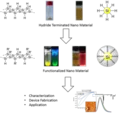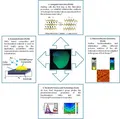| Title: | ATUMS 1-1: Electronic materials based upon conductive polymer-nanoparticle hybrids - Optoelectronic Materials |
| Partners: | University of Alberta, Edmonton, Canada & Technische Universität München TUM, Internationale Graduiertenschule für Funktionelle Hybridmaterialen (ATUMS), München, Germany |
| Funding: | funding through Deutsche Forschungsgemeinschaft DFG, Bonn, DFG IRTG 2022 "ATUMS" Project 1-1 |
| Duration: | 2015- |
| Contact: | Professor Dr. Bernhard Rieger, Technische Universität München (TUM), Fakultät für Chemie WACKER-Lehrstuhl für Makromolekulare Chemie, Garching |
| Homepage: | www.dfg.de/foerderung/programme/listen/projektdetails/index.jsp |
TUM: Peter Müller-Buschbaum, Paolo Lugli, Bernhard Rieger, Marc Tornow
UofA: Jillian Buriak, Frank Hegmann, Alkiviathes Meldrum, Eric Rivard, Jonathan Veinot
Doctoral Candidates: Arzu Angi, Tobias Helbich, Markus Pschenitza
Aim of the project / Overview
Silicon is the workhorse material of the modern electronic industry and enabled the production of ever faster and smaller devices.
In its bulk form (i.e. silicon wafer) silicon reaches its limits in terms of cost and efficiency. Therefore silicon nanomaterials are promising candidates to improve the scalability of electronic devices in the long-run, thus enabling the field of nanoelectronics.
Besides, as the dimensions of silicon are reduced below its Bohr radius (4 nm), (opto)electronic properties arise (i.e. size dependent photoluminescence, discrete band structure), which are not observed for its bulk counterpart.
Despite these appealing properties, application of colloidal quantum dots (SiQDs) in optoelectronic devices still remained limited.
This is primarily because well-defined SiQDs of tailored size/shape were not available and the typical methods for SiQD surface modification yielded insulating coatings that deteriorate (and even prevent) carrier transport.
If their morphology (i.e. shape and size) could be predictably controlled and their surface chemistry become better understood and established, SiQDs would combine all the favourable attributes of other QDs (CdSe based, etc.) such as solution processability, tailorable optical and electronic properties, as well as multiple exciton generation with the added benefit of being significantly less toxic, biocompatible and biodegradable.
In this context, surface chemistry of silicon nanomaterials is the key to the development of nanoSi-based technologies and is one focus of ATUMS.
This project aims to synthesize hybrid organic/inorganic polymer-nanomaterials for the application in electronic devices.
Efficient surface functionalization of silicon nanomaterials with organic species should facilitate stabilization against oxidation and preservation of optoelectronic properties as well as easier processability.
Additionally, via surface functionalization with elaborately chosen organic groups, effective carrier (i.e. electron and hole) delocalization from the nanomaterial into the surrounding organic matrix should be possible.
In our recent work, we established the utility of organolithium reagents to functionalize SiQDs in an efficient, mild and straightforward manner.
This method offers the advantage of direct functionalization of hydride terminated particles with conjugated species.
Grafting these groups with conjugated π‑systems can be beneficial for hybrid composites aiming towards optoelectronic devices, since they can offer a well-controlled interface for the charge transfer from/to Si‑NCs and better compatibility with the host matrices.
Besides, the optical properties of Si-NCs are altered when their surface is decorated with these conjugated systems, which can pave the way for PL wavelength tuning by means of surface functionalization.
Additionally to SiQDs, two dimensional silicon materials are examined for their potential application in nanoelectronic devices.
Due to their outstanding structural and electronic properties they are very promising candidates for this purpose.
Since these materials are not as well understood as SiQDs new insights into the functionalization of their surfaces are to be found within this project and used for the synthesis of organic/inorganic nano hybrid materials.






